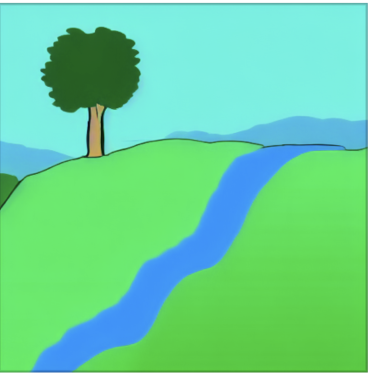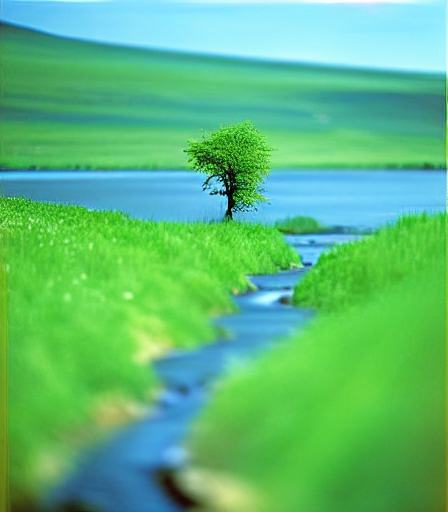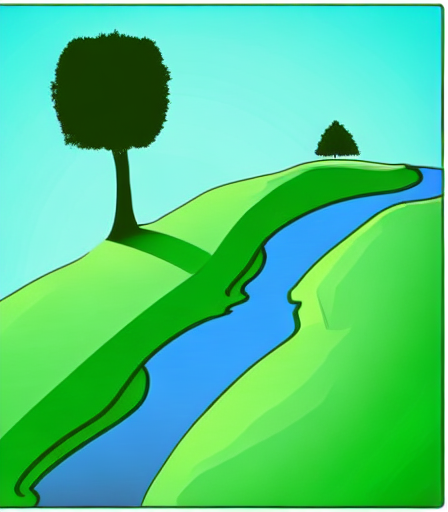mirror of
https://github.com/invoke-ai/InvokeAI
synced 2024-08-30 20:32:17 +00:00
237 lines
10 KiB
Markdown
237 lines
10 KiB
Markdown
---
|
|
title: Image-to-Image
|
|
---
|
|
|
|
# :material-image-multiple: Image-to-Image
|
|
|
|
## `img2img`
|
|
|
|
This script also provides an `img2img` feature that lets you seed your creations
|
|
with an initial drawing or photo. This is a really cool feature that tells
|
|
stable diffusion to build the prompt on top of the image you provide, preserving
|
|
the original's basic shape and layout. To use it, provide the `--init_img`
|
|
option as shown here:
|
|
|
|
```commandline
|
|
tree on a hill with a river, nature photograph, national geographic -I./test-pictures/tree-and-river-sketch.png -f 0.85
|
|
```
|
|
|
|
This will take the original image shown here:
|
|
|
|
<figure markdown>
|
|
{ width=320 }
|
|
</figure>
|
|
|
|
and generate a new image based on it as shown here:
|
|
|
|
<figure markdown>
|
|
{ width=320 }
|
|
</figure>
|
|
|
|
The `--init_img` (`-I`) option gives the path to the seed picture. `--strength`
|
|
(`-f`) controls how much the original will be modified, ranging from `0.0` (keep
|
|
the original intact), to `1.0` (ignore the original completely). The default is
|
|
`0.75`, and ranges from `0.25-0.90` give interesting results. Other relevant
|
|
options include `-C` (classification free guidance scale), and `-s` (steps).
|
|
Unlike `txt2img`, adding steps will continuously change the resulting image and
|
|
it will not converge.
|
|
|
|
You may also pass a `-v<variation_amount>` option to generate `-n<iterations>`
|
|
count variants on the original image. This is done by passing the first
|
|
generated image back into img2img the requested number of times. It generates
|
|
interesting variants.
|
|
|
|
Note that the prompt makes a big difference. For example, this slight variation
|
|
on the prompt produces a very different image:
|
|
|
|
<figure markdown>
|
|
{ width=320 }
|
|
<caption markdown>photograph of a tree on a hill with a river</caption>
|
|
</figure>
|
|
|
|
!!! tip
|
|
|
|
When designing prompts, think about how the images scraped from the internet were
|
|
captioned. Very few photographs will be labeled "photograph" or "photorealistic."
|
|
They will, however, be captioned with the publication, photographer, camera model,
|
|
or film settings.
|
|
|
|
If the initial image contains transparent regions, then Stable Diffusion will
|
|
only draw within the transparent regions, a process called
|
|
[`inpainting`](./INPAINTING.md#creating-transparent-regions-for-inpainting).
|
|
However, for this to work correctly, the color information underneath the
|
|
transparent needs to be preserved, not erased.
|
|
|
|
!!! warning "**IMPORTANT ISSUE** "
|
|
|
|
`img2img` does not work properly on initial images smaller
|
|
than 512x512. Please scale your image to at least 512x512 before using it.
|
|
Larger images are not a problem, but may run out of VRAM on your GPU card. To
|
|
fix this, use the --fit option, which downscales the initial image to fit within
|
|
the box specified by width x height:
|
|
|
|
```
|
|
tree on a hill with a river, national geographic -I./test-pictures/big-sketch.png -H512 -W512 --fit
|
|
```
|
|
|
|
## How does it actually work, though?
|
|
|
|
The main difference between `img2img` and `prompt2img` is the starting point.
|
|
While `prompt2img` always starts with pure gaussian noise and progressively
|
|
refines it over the requested number of steps, `img2img` skips some of these
|
|
earlier steps (how many it skips is indirectly controlled by the `--strength`
|
|
parameter), and uses instead your initial image mixed with gaussian noise as the
|
|
starting image.
|
|
|
|
**Let's start** by thinking about vanilla `prompt2img`, just generating an image
|
|
from a prompt. If the step count is 10, then the "latent space" (Stable
|
|
Diffusion's internal representation of the image) for the prompt "fire" with
|
|
seed `1592514025` develops something like this:
|
|
|
|
```bash
|
|
invoke> "fire" -s10 -W384 -H384 -S1592514025
|
|
```
|
|
|
|
<figure markdown>
|
|

|
|
</figure>
|
|
|
|
Put simply: starting from a frame of fuzz/static, SD finds details in each frame
|
|
that it thinks look like "fire" and brings them a little bit more into focus,
|
|
gradually scrubbing out the fuzz until a clear image remains.
|
|
|
|
**When you use `img2img`** some of the earlier steps are cut, and instead an
|
|
initial image of your choice is used. But because of how the maths behind Stable
|
|
Diffusion works, this image needs to be mixed with just the right amount of
|
|
noise (fuzz/static) for where it is being inserted. This is where the strength
|
|
parameter comes in. Depending on the set strength, your image will be inserted
|
|
into the sequence at the appropriate point, with just the right amount of noise.
|
|
|
|
### A concrete example
|
|
|
|
I want SD to draw a fire based on this hand-drawn image:
|
|
|
|
<figure markdown>
|
|

|
|
</figure>
|
|
|
|
Let's only do 10 steps, to make it easier to see what's happening. If strength
|
|
is `0.7`, this is what the internal steps the algorithm has to take will look
|
|
like:
|
|
|
|
<figure markdown>
|
|

|
|
</figure>
|
|
|
|
With strength `0.4`, the steps look more like this:
|
|
|
|
<figure markdown>
|
|

|
|
</figure>
|
|
|
|
Notice how much more fuzzy the starting image is for strength `0.7` compared to
|
|
`0.4`, and notice also how much longer the sequence is with `0.7`:
|
|
|
|
| | strength = 0.7 | strength = 0.4 |
|
|
| --------------------------- | ------------------------------------------------------------- | ------------------------------------------------------------- |
|
|
| initial image that SD sees |  |  |
|
|
| steps argument to `invoke>` | `-S10` | `-S10` |
|
|
| steps actually taken | `7` | `4` |
|
|
| latent space at each step |  |  |
|
|
| output |  |  |
|
|
|
|
Both of the outputs look kind of like what I was thinking of. With the strength
|
|
higher, my input becomes more vague, _and_ Stable Diffusion has more steps to
|
|
refine its output. But it's not really making what I want, which is a picture of
|
|
cheery open fire. With the strength lower, my input is more clear, _but_ Stable
|
|
Diffusion has less chance to refine itself, so the result ends up inheriting all
|
|
the problems of my bad drawing.
|
|
|
|
If you want to try this out yourself, all of these are using a seed of
|
|
`1592514025` with a width/height of `384`, step count `10`, the default sampler
|
|
(`k_lms`), and the single-word prompt `"fire"`:
|
|
|
|
```bash
|
|
invoke> "fire" -s10 -W384 -H384 -S1592514025 -I /tmp/fire-drawing.png --strength 0.7
|
|
```
|
|
|
|
The code for rendering intermediates is on my (damian0815's) branch
|
|
[document-img2img](https://github.com/damian0815/InvokeAI/tree/document-img2img) -
|
|
run `invoke.py` and check your `outputs/img-samples/intermediates` folder while
|
|
generating an image.
|
|
|
|
### Compensating for the reduced step count
|
|
|
|
After putting this guide together I was curious to see how the difference would
|
|
be if I increased the step count to compensate, so that SD could have the same
|
|
amount of steps to develop the image regardless of the strength. So I ran the
|
|
generation again using the same seed, but this time adapting the step count to
|
|
give each generation 20 steps.
|
|
|
|
Here's strength `0.4` (note step count `50`, which is `20 ÷ 0.4` to make sure SD
|
|
does `20` steps from my image):
|
|
|
|
```bash
|
|
invoke> "fire" -s50 -W384 -H384 -S1592514025 -I /tmp/fire-drawing.png -f 0.4
|
|
```
|
|
|
|
<figure markdown>
|
|

|
|
</figure>
|
|
|
|
and here is strength `0.7` (note step count `30`, which is roughly `20 ÷ 0.7` to
|
|
make sure SD does `20` steps from my image):
|
|
|
|
```commandline
|
|
invoke> "fire" -s30 -W384 -H384 -S1592514025 -I /tmp/fire-drawing.png -f 0.7
|
|
```
|
|
|
|
<figure markdown>
|
|

|
|
</figure>
|
|
|
|
In both cases the image is nice and clean and "finished", but because at
|
|
strength `0.7` Stable Diffusion has been give so much more freedom to improve on
|
|
my badly-drawn flames, they've come out looking much better. You can really see
|
|
the difference when looking at the latent steps. There's more noise on the first
|
|
image with strength `0.7`:
|
|
|
|
<figure markdown>
|
|

|
|
</figure>
|
|
|
|
than there is for strength `0.4`:
|
|
|
|
<figure markdown>
|
|

|
|
</figure>
|
|
|
|
and that extra noise gives the algorithm more choices when it is evaluating how
|
|
to denoise any particular pixel in the image.
|
|
|
|
Unfortunately, it seems that `img2img` is very sensitive to the step count.
|
|
Here's strength `0.7` with a step count of `29` (SD did 19 steps from my image):
|
|
|
|
<figure markdown>
|
|

|
|
</figure>
|
|
|
|
By comparing the latents we can sort of see that something got interpreted
|
|
differently enough on the third or fourth step to lead to a rather different
|
|
interpretation of the flames.
|
|
|
|
<figure markdown>
|
|

|
|
</figure>
|
|
|
|
<figure markdown>
|
|

|
|
</figure>
|
|
|
|
This is the result of a difference in the de-noising "schedule" - basically the
|
|
noise has to be cleaned by a certain degree each step or the model won't
|
|
"converge" on the image properly (see
|
|
[stable diffusion blog](https://huggingface.co/blog/stable_diffusion) for more
|
|
about that). A different step count means a different schedule, which means
|
|
things get interpreted slightly differently at every step.
|